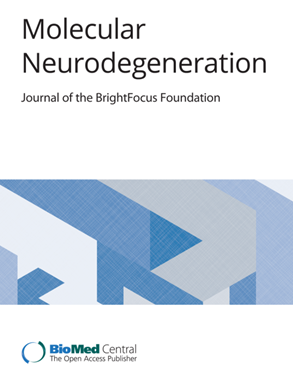在阿尔茨海默病模型中,MS4A6A/Ms4a6d缺乏破坏神经保护性小胶质细胞功能并促进炎症
IF 17.5
1区 医学
Q1 NEUROSCIENCES
引用次数: 0
摘要
阿尔茨海默病(AD)是最常见的痴呆症类型。遗传多态性与阿尔茨海默病发病风险的改变有关,指出了生物过程和干预的潜在目标。与小胶质细胞在阿尔茨海默病发展中的重要作用相一致,在小胶质细胞上表达的几个基因的基因突变已被确定为阿尔茨海默病的风险。新出现的证据表明,小胶质细胞特异性基因MS4A6A的表达被认为与AD有关,因为AD患者表现出MS4A6A的上调,其水平与临床神经病理的严重程度相关。然而,MS4A6A与AD的联系机制尚未得到实验研究。我们对734,121名受试者进行了meta全基因组关联分析,以研究MS4A6A多态性与AD风险之间的关系。此外,我们分析了MS4A6A与ad相关脑脊液生物标志物之间的相关性。此外,我们首次建立了Ms4a6d缺失的APP/PS1模型,并使用高分辨率显微镜、生物化学和行为分析系统地检查了病理变化。我们发现了几个与阿尔茨海默病风险改变有关的MS4A6A新突变,并发现其中一些突变与脑脊液中β-淀粉样蛋白的含量有特定的相关性。MS4A6A的保护性变异与该基因的表达升高有关。缺乏Ms4a6d导致大脑中淀粉样蛋白清除减少。死后AD患者脑免疫染色显示MS4A6A在小胶质细胞中选择性表达。在缺乏Ms4a6d的APP/PS1小鼠中,小胶质细胞的淀粉样蛋白包膜和吞噬明显减少,导致斑块负担增加,结构不致密,突触损伤更严重。重要的是,Ms4a6d缺乏通过抑制NF-κB信号传导,显著加剧了小胶质细胞和星形胶质细胞的炎症反应。在人小胶质细胞中过表达MS4A6A可促进与斑块相关反应相关的基因表达,并减少炎症特征。我们的研究结果表明,Ms4a6d缺乏抑制神经保护并加重神经炎症。足够的Ms4a6d可能有利于促进淀粉样蛋白相关反应和抑制小胶质细胞的炎症,使其优于先前报道的小胶质细胞调节候选物。因此,AD中MS4A6A水平升高可能是代偿性的,提高MS4A6A水平可能是一种有效的治疗方法。本文章由计算机程序翻译,如有差异,请以英文原文为准。
MS4A6A/Ms4a6d deficiency disrupts neuroprotective microglia functions and promotes inflammation in Alzheimer’s disease model
Alzheimer’s disease (AD) is the most common type of dementia. Genetic polymorphisms are associated with altered risks of AD onset, pointing to biological processes and potential targets for interventions. Consistent with the important roles of microglia in AD development, genetic mutations of several genes expressed on microglia have been identified as risks for AD. Emerging evidences indicate that the expression of a microglia-specific gene MS4A6A is thought to be associated with AD, since AD patients show upregulation of MS4A6A, and its levels correlate with the severity of clinical neuropathology. However, the mechanism linking MS4A6A and AD has not been experimentally studied. We performed a meta genome-wide association analysis with 734,121 subjects to examine the associations between polymorphisms of MS4A6A with AD risks. In addition, we analyzed the correlation between MS4A6A and AD-related cerebrospinal fluid biomarkers from our own cohort. Furthermore, we for the first time generated a Ms4a6d deficient APP/PS1 model, and systematically examined pathological changes using high-resolution microscopy, biochemistry, and behavioral analysis. We identified several new mutations of MS4A6A with altered AD risks, and discovered specific correlation for some of them with the amount of β-amyloid in cerebrospinal fluid. Protective variant of MS4A6A is associated with elevated expression of the gene. Deficient Ms4a6d led to reduced amyloid clearance in the brain. Immunostaining from postmortem AD patients brain revealed selective expression of MS4A6A in microglia. In APP/PS1 mice lacking Ms4a6d, microglia showed markedly diminished envelopment and phagocytosis of amyloid, leading to increased plaque burden, less compact structure, and more severe synaptic damage. Importantly, Ms4a6d deficiency markedly exacerbated inflammatory responses in both microglia and astrocytes by disinhibiting NF-κB signaling. Overexpressing MS4A6A in human microglia cell line promoted gene expression related to plaque-associated responses and diminished inflammation signatures. Our findings reveal that Ms4a6d deficiency suppresses neuroprotection and worsens neuroinflammation. Sufficient Ms4a6d maybe beneficial for boosting amyloid-related responses and suppressing inflammation in microglia, making it superior than previously reported candidates for microglia modulation. Thus, the elevated MS4A6A levels in AD are likely compensatory and boosting MS4A6A could be an effective treatment.
求助全文
通过发布文献求助,成功后即可免费获取论文全文。
去求助
来源期刊

Molecular Neurodegeneration
医学-神经科学
CiteScore
23.00
自引率
4.60%
发文量
78
审稿时长
6-12 weeks
期刊介绍:
Molecular Neurodegeneration, an open-access, peer-reviewed journal, comprehensively covers neurodegeneration research at the molecular and cellular levels.
Neurodegenerative diseases, such as Alzheimer's, Parkinson's, Huntington's, and prion diseases, fall under its purview. These disorders, often linked to advanced aging and characterized by varying degrees of dementia, pose a significant public health concern with the growing aging population. Recent strides in understanding the molecular and cellular mechanisms of these neurodegenerative disorders offer valuable insights into their pathogenesis.
 求助内容:
求助内容: 应助结果提醒方式:
应助结果提醒方式:


